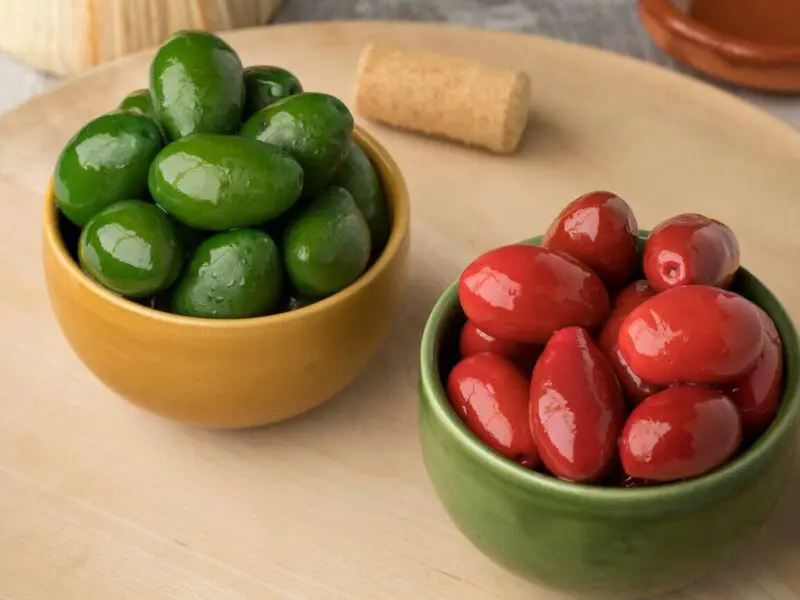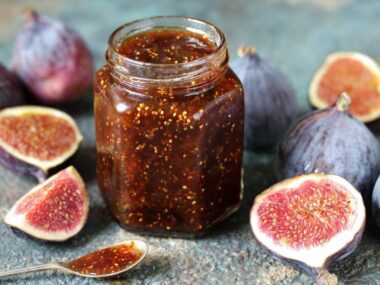You’re dreaming of whipping up a fresh antipasto board with all the classic Mediterranean flavors. But when you get to the store, you find they’re all out of those juicy Cerignola olives you love. Bummer, right? Now what are you supposed to do with your charcuterie and cheeses?
Fear not – I’ve been in your olive-less shoes before, and believe me, it’s a crisis everyone who appreciates good food has faced at one time or another. But don’t despair, because there are definitely options out there to satisfy your olive craving without compromising on taste.
In this article, I’ll be spilling all the secrets to the best alternative olives you can use when your usual go-to Cerignolas aren’t available. From tiny apples to über-meaty, supersized rounds, we’ll explore substitutes from Spain, Italy, and beyond. By the time you’re done, you’ll have a whole new appreciation for olives and a stocked pantry ready for any unexpected food shortages. So let’s get cracking and find you the perfect substitute to save your spread!
Best Cerignola Olives Substitutes
1. Manzanilla Olives
When it comes to mild-flavored olives with nuanced taste, the first substitute that comes to mind is Manzanilla. Hailing from Seville, Spain, these little olives resemble small green apples that are equally as delicious.
You may have spotted the diminutive Manzanillas floating in a dry sherry or gracing tapas platters. Their signature spherical shape and pale hue make them instantly recognizable. But don’t let their tiny size fool you – they pack a big punch of flavor.
Biting into a plump Manzanilla olive, your taste buds will rejoice in its vibrantly fruity notes with just a kiss of salt for balance. Their characteristic buttery quality really shines through. This richness comes from Manzanillas’ super high olive oil content, nearly 20%!
While not as large as meaty Cerignolas, Manzanillas are no less versatile. Their mild flavor profile effortlessly enhances martini cocktails, as well as classic Spanish dishes like tortilla española and patties of goat cheese. Plus, their compact size makes for perfect cocktail snacks or tapas toppings.
2. Castelvetrano Olives
Hail from the town of Castelvetrano in Sicily’s westernmost province of Trapani. What sets these olives apart is their vivid green hue—a natural pigment you won’t find enhanced by dyes or brining solutions.
Bite into a plump Castelvetrano and you’ll taste why these beauties have become renowned for their uniquely creamy texture and mild, sweet flavor profiles. Their flesh offers a lovely balance of grassy notes with a subtle savory undertone.
Thanks to their pleasantly mild taste, Castelvetranos appeal to both olive skeptics as well as die-hard fans. Their versatility also means they pair stunningly with a wide range of dishes.
For antipasti, their bright color and taste make them an elegant choice alongside mozzarella or Burrata cheese. They also compliment chopped tomatoes perfectly in a Caprese salad.
On pizzas and flatbreads, Castelvetranos provide a peppery pop without overwhelming other toppings. Their mildness also suits seafood, like tuna, nicely.
3. Gordal Olives
When it comes to olives with serious size and serious flavor, none compare to the revered Gordal from Spain. As its name implies, meaning “fat one” in Spanish, this is an Extra Large olive packed with intense meaty richness.
Originating from the Huelva province of western Andalusia, Gordals grow abundantly on tall, slender trees. They’re by far one of the largest types, oval in shape and ranging from half an inch to over an inch in length.
Bite into a plump Gordal and your taste buds will delight in its firm yet creamy texture and pronounced olive flavor. Expect robust peppery and fruity tones with a distinctive natural bitterness that’s more prominent than milder varieties.
This assertive taste makes Gordals extremely versatile. They satisfy when eaten alone or work well as bold flavor bombs in recipes. Many Spaniards stuff them with garlic or roasted peppers.
Their size also means they’re ideal for spearing with toothpicks, and they offer more nibbling substance than smaller olives. Gordals even hold up well when sandwiched inside panini or topped with bruschetta.
4. Picholine Olives
For a bright alternative to Cerignola olives, look to the Picholine. Found growing abundantly along the Mediterranean coastlines of Morocco, Italy, and southern France, these green beauties have a uniquely citrus-forward flavor.
Bite into a plump Picholine and you’ll taste vibrant notes of lemon zest and lime. Their snappy acidity is balanced by an olive richness and just a hint of natural bitterness.
Farmed since Roman times, Picholines have earned a stellar reputation in European cuisine. Their petite yet meaty interior and snug almond shape make them utterly irresistible as a snatched snack or ingredient in dishes.
Their zesty kick adds zip to seafood applications like crusty bread with tuna confit. Picholines also play well with ingredients like parsley, capers, and shallots for an herby Niçoise salad.
Thanks to their mild tartness, picholines even appeal to folks wary of strong olives. Their perky citrus personality brightens up antipasti without overwhelming other flavors too.
5. Barnea Olives
For an olive with rich complexity beyond its brine, search no further than the Barnea. Grown extensively in Israel, Argentina and Australia, these olives have a seductively smooth, velvety texture and intensely savory taste like no other.
Take a bite and you’ll savor a uniquely nutty profile akin to roasted almonds or hazelnuts. Subtle sweetness balances an herbal saltiness, while a gentle bitterness lingers deliciously on the palate.
Barnea’s opulent quality stems from their oil concentration exceeding a remarkable 30% – nature’s gift for creating one seriously satisfying snack. Simply put, these olives demand your undivided attention with each bite.
Such unctuous richness lends itself naturally to creamy preparations. Imagine them nestled inside buttery brioche or paired with soft cheeses like brie. Speared alongside meats on a charcuterie board also accentuates their complexity.
6. Gaeta Olives
When in need of an intensely savory olive with nuanced tastes beyond the norm, look no further than beloved Gaeta olives of Italy. Hailing from the coastal region surrounding Gaeta, these beauties come in two distinct styles – dry-cured wrinkled wrinkles or plump and brine-cured – but both impress mightily.
Take a bite of any Gaeta, and an exquisite dance of flavors dances across your tongue. Expect an initial salinity followed by complex notes of herb, spice and ripe fruit. Their flesh strikes the ideal balance of tender yet chewy.
This balanced savoriness makes Gaetas a chef’s dream ingredient. Try them chopped as a bruschetta topping alongside tomatoes or blended into rustic pasta sauces. They also shine when folded into focaccia or tucked into frittatas still warm from the skillet.
Whether popping whole, ripe Gaetas into your mouth or sprinkling their crinkled skins onto salads, these olives uphold a standard of superior taste that keeps aficionados coming back for more. They satisfy like no other where Cerignola once reigned.
Buying Guide: Picking the Perfect Olive Substitute
Now that you’re equipped with an arsenal of standout Cerignola alternatives, it’s time to put that knowledge into action at the store. But how can you ensure the olives you bring home live up to their true potential? Here are some tips:
Freshness First – Check Best By dates and avoid brines that have changed color or texture. Olives like humans enjoy brief lifespans.
Simple Ingredients – Select olives packed in water, salt or olive oil only for purest expression of varietal flavors.
Taste Before Buying – Take a sample if offered. High quality olives maintain vibrant taste even after harvesting seasons end.
Size Matters – Larger containers preserve best. Transfer unused portions to sealed jars once opened.
Specialty Sources – For hard-to-find varieties, check Mediterranean markets or order online from specialty retailers.
Don’t Discount Price – Cost is relative to harvests and availability. Sometimes pricier options genuinely offer superior taste.
Experiment Boldly – Try mixes of your favorite olives for amplified appetizer impact. Variety helps you discern subtle signature traits.
With these buying strategies and a bit of adventurous taste testing, you’ll discover your new favorite olives in no time to become the star of your homemade spreads. Bon appétit!
FAQ’s
What’s the difference between green and black olives?
Green olives are simply harvested earlier than black olives. As olives ripen on the tree, they transition from green to purple to black. Green olives generally have a brighter, grassier flavor while black olives can be richer and more pungent.
Can I use canned olives as a substitute for fresh ones?
Yes, canned olives can work in a pinch when fresh olives aren’t available. Look for ones packed in brine rather than salty juice. Rinse them briefly before using to reduce sodium. Their texture may not be as nice as fresh but the flavors still come through.
How long will opened olives last in the fridge?
Properly stored in the refrigerator, opened olives should keep fresh for 2-3 weeks. To prolong their shelf life, transfer remaining olives to an airtight container and cover them completely with olive oil. The oil prevents oxidization and helps retain flavor and texture.
What’s the difference between Gaeta, Kalamata and Niçoise olives?
Gaeta olives are large and come from Italy. Kalamatas are smaller, purple-black olives from Greece. Niçoise olives are larger green olives that hail from France. Each have distinct flavor profiles – Gaetas are herbaceous, Kalamatas are richer/fruitier, and Niçoises have bright acidity.
Can I use olive substitutes in olive oil?
It’s best not to substitute different olive varieties when making olive oil since each has a distinctive flavor profile. The character of the olive determines the oil’s taste. Using substitutes could alter the quality and taste of extra virgin olive oil. Stick to the olives recommended by the oil producer.
Can the olive substitutes be used for cooking as well as eating raw?
Yes, most olive substitutes can be used for cooking as well as eaten raw. Olives with milder flavors like Castelvetrano and Manzanilla are especially versatile and won’t be overwhelmed by heat. The stronger flavored olives like Gordal or Gaeta are also suitable for cooking when you want a potently flavored olive presence in the finished dish.
What is the difference between Spanish and Italian olives?
In general, Spanish olives tend to be milder, oilier and lower in acidity compared to Italian olives. Common Spanish varieties like Manzanilla and Gordal have creamy, buttery flavors while Italian olives often have brighter, more assertive flavors like the citrusy Picholines or robust Gaetas. California olives also tend to be milder due to ideal growing conditions.
Can olives go bad? How can you tell?
Yes, olives can spoil over time. Signs they have gone bad include a slimy or mushy texture, excessively soft/collapse flesh, strange smells/odors, or signs of mold growth. Olives also start to degrade in flavor and aroma as they age. As a rule of thumb, avoid any olives that show obvious signs of spoilage or deterioration in texture and taste.
Can olive substitutes be used for martinis as well as dishes?
Absolutely. Many of the olive varieties mentioned make excellent martini garnishes due to their complex flavors that complement gin or vodka. Some especially good olive-forward martini choices include Manzanilla, Castelvetrano, Picholine or high-quality mixed olives. Their unique flavor profiles provide an alternative to standard black or green olives used in cocktails.
Conclusion
In conclusion, while nothing can truly replace the taste of a flawless Cerignola olive, this guide has hopefully expanded your horizons to new favorite substitutes. From tangy Picholines to richly unctuous Barneas, each variety highlighted here brings its own special charms to the table.
The best advice is to explore the wide world of olives without limits. Mix and match varieties in recipes based on what flavors you crave. Sample them alone as thoughtful snacks or impromptu tapas.
Most of all, keep an open mind when your go-to olives aren’t available. Remember, necessity is the mother of culinary adventure. You never know what new favorites may surprise you.



